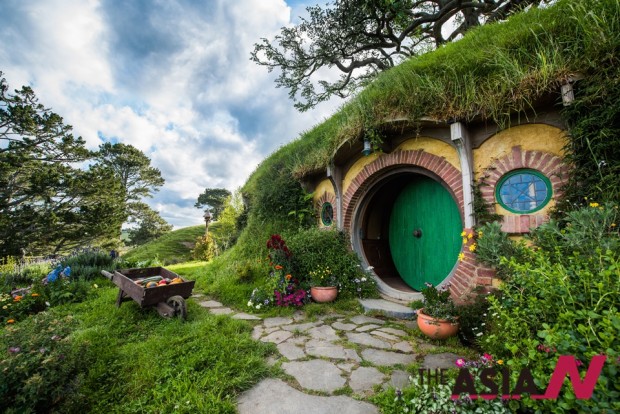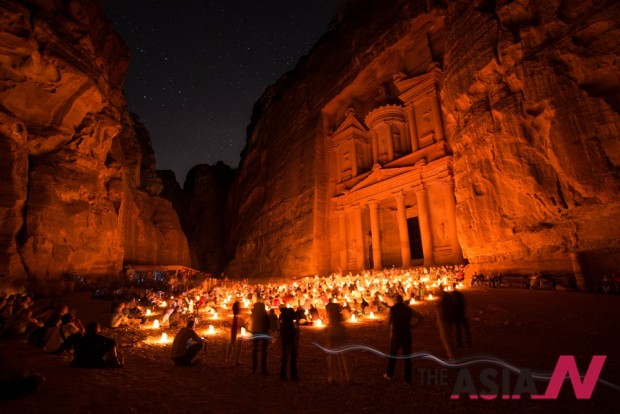영화촬영지의 ‘무한확장’…스튜디오서 오감 느끼는 현장으로

영화 <호빗>의 촬영지가 된 뉴질랜드
* ‘아시아엔’ 연수 외국기자가 작성한 기사의 한글요약본과 원문을 함께 게재합니다.
[아시아엔=?라드와 아시라프 기자·번역 최정아 기자] ‘영화·드라마 촬영지 순례’란 말을 들어봤는가? 최근 TV·스크린 속 인기 스타들이 다녀간 장소가 ‘관광명소’로 재탄생하면서 대중들 사이에서 큰 인기를 끌고 있다. 엘비스 프레슬리의 그레이스랜드, 페르 라쉐즈 공동묘지에 안식하고 있는 가수 짐 모리슨의 묘지 등이 대표적인 예다.
1990년대 초, 보잘 것 없었던 캐나다의 작은 시골마을은 세계적인 유명 관광지로 떠올랐다. 이곳은 세계적인 인기를 모았던 미국 드라마 <스타트랙>에서 인기 캐릭터 ‘스팍’(Spock)의 고향 불칸(Vulcan)으로 그려진 곳이다. <스타트랙>은 ‘대박난’ 작품 하나가 지역 경제를 어떻게 활성화 시킬 수 있는지 여실히 보여준다. 이처럼 좋은 작품은 불모지도 유명 관광지로 탈바꿈시킨다.
한국 또한 ‘한류’의 영향으로 지난 수년간 관광객 수가 급증했다. 관광객 대다수는 스크린 속 장면을 직접 두 눈으로 보고 느끼기 위해 한국을 찾는다. 일본도 마찬가지다. 애니메이션, 아이돌 등 일본 대중문화를 사랑하는 팬들은 일본 문화를 직접 느끼고 싶어 한다. 최근엔 튀니지, 요르단과 같은 아랍 국가들의 인기도 높아지고 있다. <스타워즈>와 <인디아나 존스>의 촬영지로 알려졌기 때문이다.
하지만 기대가 큰 만큼 실망도 클 수 있다. 수많은 도시들이 ‘영화 촬영지’ 혹은 ‘유명 배우가 영화 속에서 밥 먹었던 곳’이라 홍보하며 관광객들을 끌어 모으고 있지만, ‘반짝 인기’로 끝나는 경우도 흔하다. 가장 대표적인 사례는 바로 <트와일라잇>이다. <트와일라잇>의 폭발적인 인기로 한때 주 촬영지였던 미국 소도시 폭스(Forks)에 관광객이 쏟아졌다. 하지만 영화의 인기가 사라지면서 이곳을 찾는 관광객도 사라졌다.
영화 촬영지는 더 이상 스튜디오에 국한되지 않는다. 사람들은 스튜디오를 방문하고 일부 소품을 보는 것에 만족하지 않는다. 사람들은 작품을 직접 오감으로 느낄 수 있는 ‘진짜 촬영지’를 원한다. 최근 많은 영화·드라마 제작사들이 촬영지를 매우 신중하게 선택하는 이유이기도 하다. 세계적인 트렌드가 된 ‘영화·드라마 촬영지 순례’는 전세계 여행가들을 유혹하고 있다.

Location vacations: how cinema transformed tourism
Pop culture tourism or film-induced travelling has become in some respects akin to pilgrimage, with its modern equivalents of places of pilgrimage being Elvis Presley’s Graceland and the grave of Jim Morrison in P?re Lachaise Cemetery, among many others. But what is a “location vacation”? Recent studies show that more people are starting to plan their vacations and travels based on where movies and TV shows they like, are shot.
In the early 1990s, a small rural community in Canada began to explore ways it could capitalize on the coincidence of the town’s name being the same as popular Star Trek Character, Mr. Spock’s home planet: Vulcan, to develop its local tourism industry. This is just an example of what film tourism can do to enhance the economic situation of entire cities, or even countries. In the same way, a good movie could lead to the prosperity of its filming location, a bad movie could destroy that place’s reputation.
Filming destinations no longer mean the filming studios. People are no longer satisfied by visiting studios and watching a few movie props. Instead they want to see real places, which have become the main drive for production companies in choosing their filming locations carefully. And while production companies are doing their best to satisfy the future tourists, countries and places of attraction are doing the same. Film tourism is a growing phenomenon worldwide, fueled by both, the growth of the entertainment industry and the increase in international travel, therefore, resulting in destinations, globally, seeking whenever and wherever possible to associate themselves with a successful film or franchise that will entice any potential film tourist to visit their destination.
Bond’s Spectre sparked interest in the region of Tyrol in Austria, while Ireland has become known as the Game of Thrones territory. Brochures were printed out to promote these places, using the commercial success of these franchises. Film-induced tourism has proven to bring in higher revenues, and its potential to revitalize rural communities and increase tourism in urban centers.
Whether it’s the main goal of a vacation, part of a family holiday or a romantic getaway, tourists proved that after being awed by historical monuments, emotional impact of a movie comes close to second place in being the main motivation in planning their vacations.
Film tourists seek to immerse themselves in another world, whether it’s a sci-fi realm or a world of magic, going back in time or jumping into a whole other dimension. But providing all of this comes at a cost, and those who usually pay it are the locals.
Daily shops turned into souvenirs stores, a wider range of hotels, locals losing their privacy, and memorabilia tacked everywhere, are just some of the aspects people might argue to be the negative sides of such an industry. Even though film tourism proves to be a quite long-lasting industry not affected by weather and seasonal changes, it still has its own list of cons.
Location vacations across the world
Almost every city in the world now promotes itself for something that sets it apart, and most cities are using movies. Misrepresentation is quite common, and the popularity of the movie or franchise should be taken into consideration as well. Forks city suffered when Twilight’s popularity died away, and with it went all the appeal the city set for itself.
Without film storylines, a castle may not be distinguishable from others. The same way many heritage sites that serve as film locations gain fame after the film is released because they obtain a new specific connotation through the movie. New Zealand became one of the most popular vacation destinations after Lord of the Rings and The Hobbit trilogies were filmed there. Now the set of Hobbiton is known to attract thousands of visitors every year. On the other side of the world, USA became known as the country of superheroes, with each city celebrating a DC or Marvel hero whose story started there, whether it’s Metropolis, Illinois, home of Superman, North Carolina, home of The Hunger Games, or New York City which has gained an iconic status in cinema in itself.
South Korea has seen a tremendous rise in Hallyu-loving tourists whose sole purpose of travel is to visit filming locations. Japan is another country that has become a well-loved destination, owing to the famous Japanese pop culture, spread mainly by anime and manga.
Arabic countries like Tunisia and Jordan, where visitors have increased from thousands to millions, thank famous franchises like Indiana Jones and Star Wars for filming there.
Britain ? home of fairytales
Figures released by “Creative England”, the body funded by the British Film Institute to help companies find locations, show that, in 2015, it supported more than 1,100 film and television projects, a record for the third successive year.
England’s transformation into a giant movie set is a far cry from 2006 when the BBC caused a fad by opting to film Robin Hood in Hungary because it was cheaper than doing it in the UK. Since then the change in the financial climate played its part.
“It has period villages still. It has magnificent forests and woods with ancient trees with scale and size, and that was thrilling to find. It has castles…It just lends itself to that so beautifully,” said American filmmaker Rob Marshall about England, when he chose it as a filming location for his 2014 Disney movie Into the Woods and we can see why he was attracted, like many before him, to the magic of England.
Before movies and TV shows, England was already a massive attraction by itself, but there’s no denying that The Beatles’ name, for example, brought more revenue to Liverpool, and William Shakespeare’s hometown Stratford-upon-Avon receives millions of visitors every year just because of him. But then cinema came along, and the magic of England was revealed in all of its galore.
Doctor Who, Merlin, Assassin’s Creed, The Huntsmen, The Iron Lady, Victor Frankenstein, Suffragette, and Captain America all have one thing in common: they are all shot in Britain. But of course Harry Potter franchise is what started the craze for portraying England in movies, when Alnwick Castle was chosen as Hogwarts for the first movies, and the Forest of Dean was chosen as a main location for later films. That same forest was featured in the latest Star Wars movie, The Force Awakens. Now hardly a week passes without it receiving an inquiry from production scouts, eager to capture its mysterious beauty for the big screen.
Be it due to the adaptations of famous English classics such as Austen’s Pride and Prejudice, and Sense and Sensibility, to BBC’s latest rendition of Sherlock Holmes in the modern-day Sherlock that makes you look at London in a different light, England seems to be one of the most favorable destinations for movie lovers.





